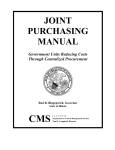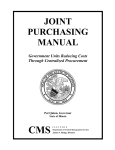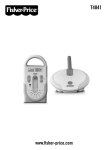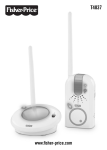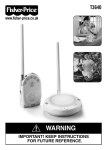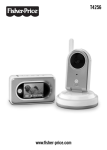Download Fisher-Price T4840 Satellite Radio User Manual
Transcript
T4840 www.fisher-price.com IMPORTANT! DANGER To prevent electric shock, do not immerse in water; wipe clean with damp cloth. WARNING To prevent strangulation with power cord, never place transmitter within reach of child. CAUTION This product cannot replace responsible adult supervision. 2 IMPORTANT! • For proper setup and use, please read these instructions. • Please keep this instruction sheet for future reference, as it contains important information. • Transmitter operates on AC current (use enclosed AC adaptor) or DC current (four “AAA” batteries, included). • Receivers operate on AC current (use enclosed AC adaptors) or DC current (six “AAA” LR03 alkaline batteries, not included). Note: A plastic tab is attached to the transmitter for in-store demonstration purposes. While the tab may have already been removed, check the transmitter to be sure. If the plastic tab is still attached, pull and remove the tab from the transmitter. Throw the plastic tab away. • Adult setup is required. • Tool needed for battery installation: Phillips screwdriver (not included). • This product is not intended to be used as a medical monitor and its use should not replace adult supervision. • Test sound reception of receivers before first-time use and whenever you change location of the transmitter. • To prevent entanglement: - Never place transmitter in a crib or playpen. Keep transmitter and receivers out of baby’s reach. - Never use extension cords with the AC adaptors. • Adults Note: Periodically examine the AC adaptors for damage to the cord, housing or other parts that may result in the risk of fire, electric shock or injury. If an AC adaptor is damaged, do not use it. • Never use transmitter or receivers near water (i.e. bathtub, sink, wet basement, etc.). • Always use the transmitter and receivers where there is adequate ventilation. To prevent overheating, keep the transmitter and receivers away from heat sources such as radiators, heat registers, direct sunlight, fire, stoves amplifiers, or other appliances which produce heat. • Do not connect the transmitter or the receivers (if AC adaptor is used) to more than the recommended number of power supplies. • An AC adaptor is not a toy. • Disconnect the AC adaptor from the transmitter and receivers before cleaning. • Fisher-Price® does not recommend the use of two monitors in one house. • Always remember that you are using public airwaves when using your monitor. Conversations, even from rooms near your transmitter, may broadcast to other nursery monitors, radios, cordless telephones or scanners outside your home. To protect the privacy of your home, always turn off the transmitter when not in use. • Carrier Frequency - 900 MHz • Product features and decoration may vary from photographs. 3 Fisher Price, Inc., a subsidiary of Mattel, Inc., East Aurora, NY 14052 U.S.A. ©2010 Mattel, Inc. All Rights Reserved. ® and ™ designate U.S. trademarks of Mattel, Inc. PRINTED IN CHINA T4840a-0920 Features 1 4 3 2 Transmitter 5 9 7 10 11 BACK VIEW 14 8 2 Receivers 12 13 SIDE VIEW 5 6 Features 1 Nightlight Button – Press to turn on a soft glow. 2 Nightlights 3 Power Button and L.E.D. 4 Microphone 5 Nightlight Timer Switch - Turn on for 30 minutes of light. 6 Channel Switch - Choose from four different channels. 7 Power/Volume Dial 8 Power L.E.D. and Range Indicator - Lights when receiver power is ON; flashes (and you’ll hear a tone too) when the receiver is out of range of transmitter. 9 Sound Lights – Watch these lights to see baby’s sounds. 10 Start/Stop Button - Press the button to start the nap timer; press the button again to stop the nap timer. Press and hold the button to set the clock time. 11 Reset Button - Press and hold the button to reset the nap timer. Use this button in clock set mode to make selections. 12 LCD Screen 13 Channel Switch - Choose from four different channels. 14 Clip - (backside of receivers) - Fasten to your clothes to stay in touch with baby around the house or yard. 6 Receiver Battery Installation (Optional) Hint: We recommend using alkaline batteries for longer battery life. 1,5V x 3 “AAA” (LR03) • Locate the battery compartment door on the back of each receiver. • Loosen the screw in each battery compartment door with a Phillips screwdriver. Remove each battery compartment door. • Insert three “AAA” (LR03) alkaline batteries into each battery compartment. • Replace each battery compartment door. Tighten the screw with a Phillips screwdriver. Do not over-tighten. 7 Transmitter Battery Replacement 1,5V x 4 “AAA” (LR03) For best performance, we recommend replacing the batteries that came with the transmitter with four, new “AAA” (LR03) alkaline batteries. • Locate the battery compartment door on the bottom of the transmitter. • Loosen the screws in the battery compartment door. Remove the door. • Insert four “AAA” (LR03) alkaline batteries into the battery compartment. • Replace the battery compartment door and tighten the screws. Hint: You can also use the included AC adaptor to power the transmitter. Battery Safety Information In exceptional circumstances, batteries may leak fluids that can cause a chemical burn injury or ruin your product. To avoid battery leakage: • Do not mix old and new batteries or batteries of different types: alkaline, standard (carbon-zinc) or rechargeable (nickel-cadmium). • Insert batteries as indicated inside the battery compartment. • Remove batteries during long periods of non-use. Always remove exhausted batteries from the product. Dispose of batteries safely. Do not dispose of this product in a fire. The batteries inside may explode or leak. • Never short-circuit the battery terminals. • Use only batteries of the same or equivalent type, as recommended. • Do not charge non-rechargeable batteries. • Remove rechargeable batteries from the product before charging. • If removable, rechargeable batteries are used, they are only to be charged under adult supervision. 8 Testing Sound Reception Test transmitter and receiver reception each time you change location of use. Channel Switch • Place the transmitter in the room where you intend to use it. • Set the transmitter channel switch to the same channel as the receiver(s). • Press the transmitter power button to turn the power ON. The power L.E.D. lights. • Turn on a radio. 9 Power Button and L.E.D. Testing Sound Reception Power/Volume Dial Sound Lights Range Indicator Channel Switch SIDE VIEW • Place a receiver in the room where you intend to use it. • Set the receiver(s) channel switch to the same channel as the transmitter. • Turn the power/volume dial to turn the power ON. Wait a few seconds to see if you have a good signal. If the range indicator light blinks along with beeping, you are out of range. Move the receiver closer to the transmitter. • When sound is picked up by a receiver, the sound lights turn on. - One or two lights indicate quieter sounds. - Three or more lights indicate louder sounds. • If the range indicator begins fl ashing, you may be experiencing interference. Try selecting a different channel on both the receiver and transmitter. If the range indicator continues to fl ash, move the receiver closer to the transmitter. 10 Setup and Use Clock Nap Timer Clock Set • Turn receiver power ON. • Press and hold the start/stop button to choose 12-hour or 24-hour clock format. Press the reset button to make a choice. • Press the start/stop button . The hour number on the clock will flash. Press the reset button to scroll through hour choices. • Press the start/stop button . The minute numbers on the clock will flash. Press the reset button to scroll through minute choices. • Press the start/stop button to confirm your selections and complete the clock setup. Receiver Battery Indicator Nap Timer Transmitter Battery Indicator Nightlight Indicator Clock Nap Timer Note: The nap timer will move to the top of the LCD screen when it is in use. • Press the start/stop button to start the nap timer. Press again to stop the time. • Press and hold the reset button to clear the timer. Battery Indicator • Displays the battery charge level of the receiver (1) and the transmitter (2). When battery power is low, the battery icon will appear partially filled. Nightlight Indicator • Indicates the transmitter nightlight is on. 11 Setup and Use Power Button and L.E.D. Channel Switch Nightlight Timer Switch Nightlight Button • Place the transmitter in the same room with child. Point the microphone towards the crib or play area. • Set the transmitter channel switch to the same channel as the receiver(s). • Unwrap and fully extend the AC adaptor for best transmission. Insert the AC adaptor pin into the DC input jack on the transmitter and plug into a standard wall outlet. Use the AC adaptor only in a wall outlet. Do not plug into a ceiling outlet. Note: To use battery power, refer to the Battery Installation section. • Press the transmitter power button to turn the power ON. The power L.E.D. will light. • Press the nightlight button for a soft, glowing light. Press again to turn the nightlight off. • Slide the nightlight timer switch to turn the timer on. When the timer is on the nightlight will automatically shut off after 30 minutes. To turn the nightlight back on for another 30 minutes, simply press the nightlight button again. 12 Setup and Use Power/Volume Dial Range Indicator Sound Lights • Place a receiver where you can see and hear it. • To use AC power, unwrap and fully extend the AC adaptor cord for best reception. Insert the AC adaptor pin into the DC input jack on the receiver and plug into a standard wall outlet. Use the AC adaptor only in a wall outlet. Do not plug into a ceiling outlet. Note: To use battery power, refer to the Battery Installation section. • Turn the power/volume dial to turn the power ON. Turn the dial to adjust the volume to a comfortable listening level. • Clip the receiver onto your clothes to stay in touch with baby around your house or yard. Hint: The receiver’s range is up to 900 feet (274 m) away from the transmitter. The range indicator will flash and you will hear beeping when the receiver is out of range. 13 Problems & Solutions Problem Solution Receiver range indicator light flashes Receiver is out of range of transmitter. Move receiver closer to transmitter. and you hear beeping Note: Range varies depending on surrounding conditions such as noise levels, physical obstructions and signal interference. Channel switch on transmitter and receiver are not the same. Switch transmitter and receiver(s) to the same channel. Transmitter power is off. Turn transmitter power on. Batteries in receiver are weak or dead. Replace all batteries with three “AAA” (LR03) alkaline batteries or use the AC adaptor as a power source. No power to wall outlet and transmitter power is off. Make sure light switch that controls power flow to wall outlet is on. Power is off because circuit breaker for room is off. Make sure house fuses and circuit breakers are on. Receiver power L.E.D. does not light at all Receiver power is off. Turn receiver power on. Batteries in receiver are weak or dead. Replace all batteries with three “AAA” (LR03) alkaline batteries or use the AC adaptor as a power source. Power is off because circuit breaker for room is off. Make sure house fuses and circuit breakers are on. No power to wall outlet and power is off. Make sure light switch that controls power flow to wall outlet is on. Receiver (1)/transmitter (2) battery indicator is only partially filled Batteries are weak or dead. Replace all batteries with new “AAA” (LR03) alkaline batteries or use the AC adaptor as a power source. Receiver screen is fading Batteries are weak or dead. Replace all batteries with new “AAA” (LR03) alkaline batteries or use the AC adaptor as a power source. Transmitter power L.E.D. does not light at all Transmitter power is off. Turn transmitter power on. Batteries in transmitter are weak or dead. Replace all batteries with four “AAA” (LR03) alkaline batteries or use the AC adaptor as a power source. Check transmitter power cord plug-to-outlet connection. No power to wall outlet and transmitter power is off. Make sure light switch that controls power flow to wall outlet is on. Power is off because circuit breaker for baby’s room is off. Make sure house fuses and circuit breakers are on. You can hear conversations or sounds from other homes There is signal interference due to other nursery monitors on same channel or cordless telephone use. Change channel switches on both transmitter and receiver to eliminate source of interference. Clock/nap timer is not working or is functioning erratically Reset the receiver by removing the batteries and replacing them in the receiver. Hint: If, after checking all of these solutions, you believe that your transmitter power cord or AC adaptor are damaged, please contact Fisher-Price®. 14 FCC Statement (United States Only) This equipment has been tested and found to comply with the limits for a Class B digital device, pursuant to part 15 of the FCC rules. These limits are designed to provide reasonable protection against harmful interference in a residential installation. This equipment generates, uses and can radiate radio frequency energy and, if not installed and used in accordance with the instructions, may cause harmful interference to radio communications. However, there is no guarantee that interference will not occur in a particular installation. If this equipment does cause harmful interference to radio or television reception, which can be determined by turning the equipment off and on, the user is encouraged to try to correct the interference by one or more of the following measures: Reorient or relocate the receiving antenna. Increase the separation between the equipment and receiver. Connect the equipment into an outlet on a circuit different from that to which the receiver is connected. Consult the dealer or an experienced radio/TV technician for help. Note: Changes or modifications not expressly approved by the manufacturer responsible for compliance could void the user’s authority to operate the equipment. Monitor Model Number: T4840 This device complies with Part 15 of the FCC Rules. Operation is subject to the following two conditions: (1) This device may not cause harmful interference and (2) this device must accept any interference received, including interference that may cause undesired operation. Monitor Consumer Relations Department 636 Girard Avenue East Aurora, New York 14052, U.S.A. 15 ICES-003 NMB-003 ICES-003 This Class B digital apparatus complies with Canadian ICES-003. Operation is subject to the following two conditions: (1) this device may not cause harmful interference and (2) this device must accept any interference received, including interference that may cause undesired operation. NMB-003 Cet appareil numérique de la classe B est conforme à la norme NMB-003 du Canada. L’utilisation de ce dispositif est autorisée seulement aux conditions suivantes : (1) il ne doit pas produire de brouillage et (2) l’utilisateur du dispositif doit être prêt à accepter tout brouillage radioélectrique reçu, même si ce brouillage est susceptible de compromettre le fonctionnement du dispositif. Care • Excess dirt in the transmitter microphone will hamper transmission of sound. Clean the outer surface of the transmitter and the receivers with a cloth lightly dampened with a mild cleaning solution. • Never immerse the transmitter, receivers or AC adaptors. • Protect the environment by not disposing of this product with household waste (2002/96/EC). Check your local authority for recycling advice and facilities (Europe only). 16
















